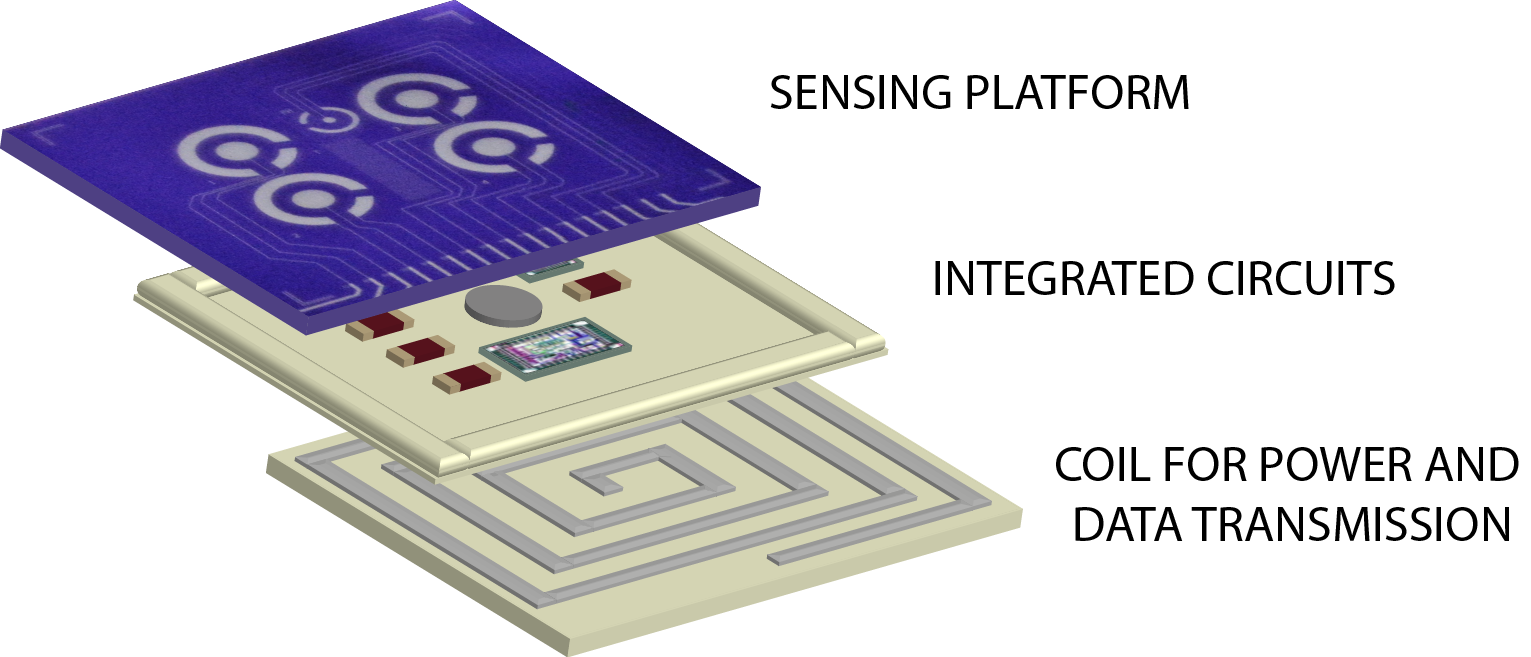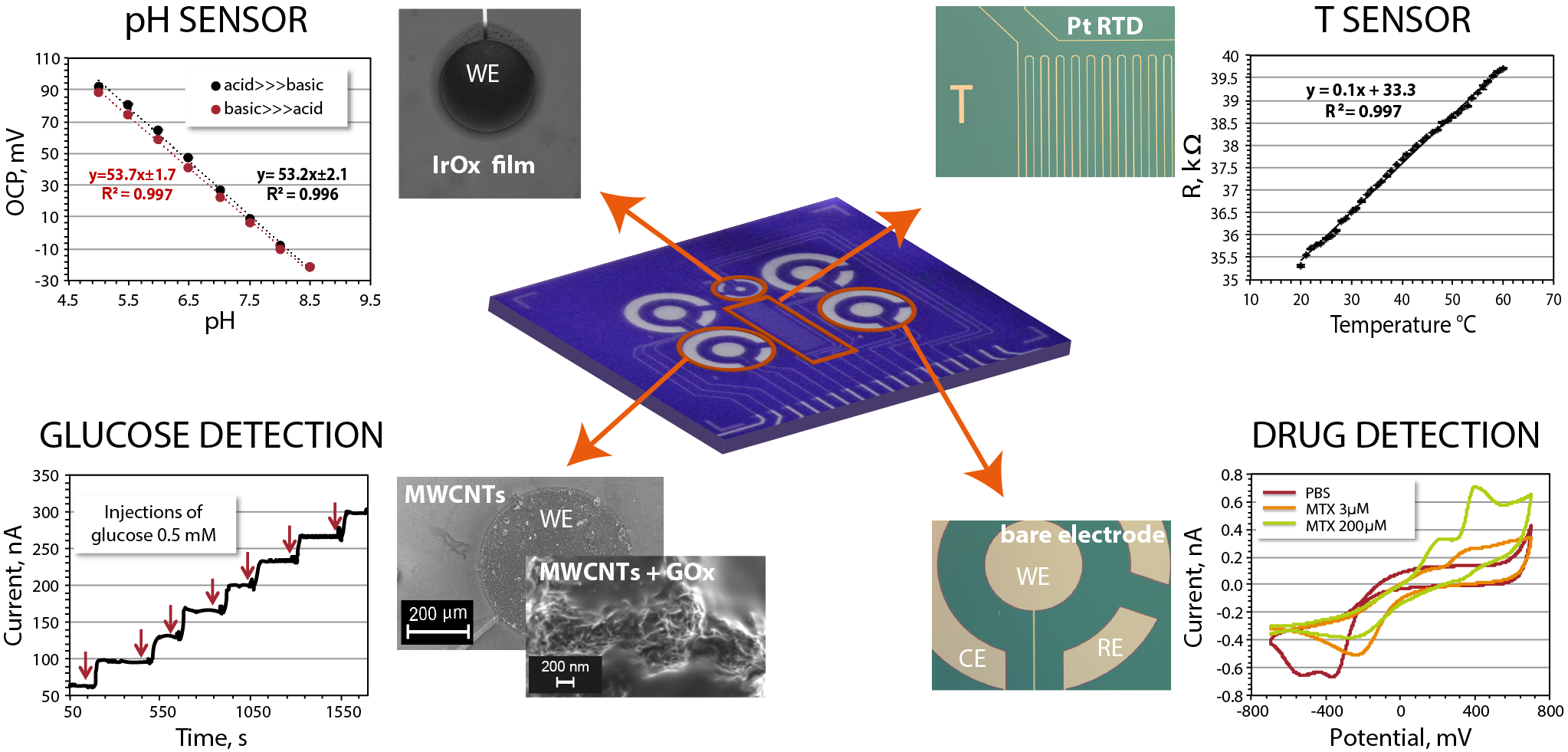Innovative systems for drug monitoring in personalized therapy
By C. Baj-Rossi, G. De Micheli and S. Carrara
A simple and versatile electronics device designed to perform, even simultaneously, electrochemical detection of different drugs and metabolites may represent an innovative solution for personalized medicine that could improve the efficacy of a drug therapy. High versatility, system miniaturization and high sensitivity are among the main advantages offered by this type of biosensor.
Despite the many impressive advances in the research for drug therapy, the promise of personalized therapy has not been fulfilled [1]. Drug therapies for major diseases benefit only 30% to 50% of patients, while approximately 7% of hospitalized patients experience adverse drug reactions [2]. The personalization of drug therapy investigates how patients respond to drugs, in order to maximize the benefic effects, while reducing the risk of adverse reactions due to toxicity or sub therapeutic dosing.
At present, pharmacogenomics, transcriptomics, proteomics and pharmaco-metabolomics represent the utmost in our ability to predict the reaction of a patient to a specific drug therapy [3]; however, in several clinical cases, a simple prediction of drug response is not sufficient to ensure safe drug administration. For example, medications with a narrow therapeutic range, patients unresponsive to a given therapy, cases of suspected toxicity, variations in the clinical status of the patient or careful assessment of the patient compliance require a continuous drug monitoring [4].
Recently, the therapeutic drug monitoring (TDM) has been proposed as a means to individually adjust the drug dosage according to the pharmacokinetics profile obtained by the precise quantification of drug concentration after administration [5]. At present, over 20 drugs are routinely monitored [4,6]. However, the cost-effective contribution of TDM to patient care is currently being debated, because the analysis relies on techniques such as high-performance liquid chromatography or mass spectrometry, which require specific equipment and are therefore costly and limited to few facilities [6].
The monitoring of drug levels with a portable electrochemical sensor could offer challenging opportunities for clinical applications [4]: automatic sampling analysis and remote data handling can significantly reduce human error during analysis and data manipulation, paving the way to the development of point-of-care sensors for home testing. This can both facilitate patients’ compliance and reduce the cost of hospitalization [7].
Electroanalytical techniques, such as cyclic voltammetry, have been found to be excellent for the determination of electroactive drugs in different biological fluids [8]. Many drug compounds have been determined by voltammetric techniques, as for antibiotics, antiemetic, antipsychotic, cardiovascular, hypoglycemic, analgesics and other drugs [9].
A strategy to measure non-electroactive drugs is to employ the enzyme family of cytochrome P450 (CYP) that are involved in the first-pass metabolism of approximately the 75% of drugs and foreign chemicals in the body. CYP-based sensors have been used for the determination of a vast range of compounds, such as verapamil [10], benzphetamine [11], anti-cancer agents [12] and many others [13].
However, since many drug therapies are based on combinations of drugs [14], it is necessary to monitor multiple drugs at the same time in order to get a more complete overview of the ongoing therapy and to enable a more precise dosage adjustment.
At present, the development of a biosensor capable of measuring a drug mixture in human blood is still not reached, and no amperometric biosensors for the continuous monitoring of drugs have been reported so far.
For this purpose, we designed a prototype of an autonomous device that may be used in different clinical applications: for monitoring drugs with a narrow therapeutic range or used in combinations (e.g. anti-cancer drugs) or important metabolites that could be relevant e.g. for chronic pathologies.
The device can be designed to be implantable subcutaneously. The main idea is to avoid a ‘discrete’ analysis as for off-line measurements, which requires the extraction of blood samples from the vein of patients and a subsequent analysis. Implantable devices could minimize the pain and discomfort for the patient and enable the continuous monitoring of the analyst of interest. For this purpose, the device must be biocompatible and battery-less, i.e. it should be autonomous in terms of power supply.
Here we show the fabrication and testing of an implantable device for the real-time drug monitoring. The current aim is to implant the device subcutaneously in mice and monitor the concentration of anti-cancer drugs that would be previously injected, in order to precisely follow the drug metabolism. In the future, the device will be adapted to work within human beings.

Figure 1: Three-dimensional assembly of the components of the implantable device [15].
The device consists of three main building blocks: (i) an inductive coil; (ii) a power management integrated circuit (IC) dealing with the energy source of the implantable microsystem to provide power; (iii) an interface IC to control and readout the biosensor; (iv) the passive sensing platform. Fig. 1 describes the assembly of the implantable device. A size of 12×12 mm size and a thickness of 2.8 mm enables its insertion in the interstitial tissue [15]. The passive platform consists of four independent electrochemical cells in the three-electrodes configuration: working electrode (WE), counter electrode (CE) and reference electrode (RE), where the WE of each sensing site is functionalized to selectively detect a single target drug or a metabolite. The sensor performances are improved using multi-walled carbon-nanotubes (MWCNTs), [16]. We also added a sensor to monitor changes in pH and a resistive thermal device (RTD) for the measurement of temperature variations, which could affect the determination of other substances via electrochemical methods. Since the biosensor is intended to be implanted inside a freely moving mouse, an external system is designed to track the animal in a living space and to adapt the transferred power, via an optimized inductive link, according to the position of the animal [17].
Excluding the sensors in contact with the fluid, the device is covered with a Parylene-C coating, necessary to prevent leaking of potential hazardous substances and the corrosion of electronic components in contact with biological fluids. Additionally, an innovative biocompatible packaging based on an epoxy enhanced polyurethane membrane was used to protect the whole chip. In-vivo biocompatibility tests were performed by implanting the devices in mice for 30 days, proving that the membrane provides a quite good biocompatible coverage [15]. With the sensing platform we performed measurements of metabolites and electroactive drugs and we calibrated the sensors for monitoring changes in pH and temperature. Fig. 2 reports a summary of the measurements obtained with the sensing platform.

Figure 2: Measurement realized with the passive platform: variations in the pH of the solution generate changes in the open circuit potential (OCP) at the WE, that is functionalized with a layer of Iridium oxide (IrOx); a resistive thermal device (RTD) that consists of a 4µm-width Pt wire linearly changes the resistor value according to the increase of the temperature in the solution; glucose is detected by chronoamperometry after the electrode functionalization with MWCNTs and glucose oxidase (GOx); an electroactive drug, such as the anti-cancer agent mitoxantrone (MTX) can be measured by cyclic voltammetry on a bare electrode.
From the perspective of the continuous monitoring of drugs, a preliminary study was conducted on the possibility to employ electrochemical sensor based on CYP for the sensitive monitoring of a drug continuously delivered by an osmotic pump. For this study CYP was adsorbed on an MWCNT-modified screen-printed electrode [18]. The biosensor was successfully applied to the real-time monitoring of naproxen, an anti-pyretic drug, for 16 h.
These results show that this electrochemical sensor provides high sensitivity and extreme simplicity in sensor preparation, all features that are suitable for the development of a point-of-care sensor, but that the sensor stability in time is dependent on the enzyme activity. From this perspective it emerges the importance of the optimization of the sensing performances in order to achieve an accurate and stable real-time drug monitoring, which is highly desired in case of patients with non-steady drug dosage results, in intensive care units, during surgery, in the management of diseases, such as diabetes or cancer, in cases of high pharmacokinetics variability, as it provides the option to detect unexpected changes with a rapid corrective action.
Future steps will include continuous drug measurements with the microfabricated platform, an evaluation on the effect of interfering substances from biological fluids on the sensing performances and in-vivo tests in animals with the implanted device.
In summary, implantable electrochemical biosensors offer many advantages to be applied for the TDM practice, including device miniaturization, high sensitivity and high versatility. With our sensing platform we shown as a possible main application the individualization of pharmacological treatments, but it is possible to envisage many other goals for this device. The sensors described in this article can be conceived in alternative embodiments, for example as needles, to track critical drugs during surgeries and anesthesia, or designed to be implanted in the uterus to perform fertility studies in women.
Acknowledgments
The research work mentioned were in collaboration with the RFIC Group of Swiss Federal Institute of Technology (EPFL), Universita’ of Genoa (Italy) and the Institute for Research in Biomedicine (IRB) from Bellinzona (Switzerland). Sara S. Goreishizadeh and Enver G. Kilinc are acknowledged for their contribution for the design and realization of the implantable device. Irene Taurino is acknowledged for the acquisition of SEM images.
The SNF Sinergia Project, code CRSII2_147694 / 1 and title “Enabling Micro-Nano-Bio-technologies for Implantable systems in molecular medicine and personalized therapy (Project prolongation)” financially supported this research.
For Further Reading
1. W. Sadee, and D. Zunyan. “Pharmacogenetics/genomics and personalized medicine.” Human molecular genetics, vol. 14, suppl 2, pp. 207-214, 2005.
21. S. D. Undevia, G. Gomez-Abuin, and M. J. Ratain, “Pharmacokinetic variability of anticancer agents,” Nature Reviews Cancer, vol. 5, pp. 447-58, 2005.
3. D. W. Nebert, and E.S. Vesell, “Can personalized drug therapy be achieved? a closer look at pharmaco-metabonomics”, Trends in pharmacological sciences, vol. 27, issue 11, pp. 580, 2006.
4. A. S. Gross, “Best practice in therapeutic drug monitoring”, British journal of clinical pharmacology, vol. 46, issue 2, pp. 95-99, 2002.
5. R. E. Aarnoutse, J. M. Schapiro, C.A.B. Boucher, Y.A. Hekster, and D. M. Burger, “Therapeutic Drug Monitoring”, Drugs, vol. 63, issue 8, pp. 741-753, 2003.
6. C. Hiemke, “Clinical utility of drug measurement and pharmacokinetics-therapeutic drug monitoring in psychiatry”, European journal of clinical pharmacology, vol. 64, issue 2, pp.159-166, 2008.
7. P. D’Orazio, “Biosensors in clinical chemistry-2011 update”, Clinica Chimica Acta, vol. 412, issue 19, pp. 1749-1761, 2011.
8. N.A. El-Maali, “Voltammetric analysis of drugs”, Bioelectrochemistry, vol. 64, issue 1, pp. 99-107, 2004.
9. V.K. Gupta, R. Jain, K. Radhapyari, N. Jadon, and S. Agarwal, “Voltammetric techniques for the assay of pharmaceuticals-A review”, Analytical Biochemistry, vol. 408, issue 2, pp. 179-196, 2011.
10. S. Joseph, J.F. Rusling, Y.M. Lvov, T. Friedberg, and U. Fuhr, “An amperometric biosensor with human {CYP3A4} as a novel drug screening tool”, Biochemical Pharmacology, vol. 65, issue 11, pp. 1817-1826, 2003.
11. V.V. Shumyantseva, Y.D. Ivanov, N. Bistolas, F.W Scheller, A.I. Archakov, and U. Wollenberger, “Direct electron transfer of cytochrome p450 2b4 at electrodes modified with nonionic detergent and colloidal clay nanoparticles”, Analytical chemistry, vol. 76, issue 20, pp. 6046-6052, 2004.
12. C. Baj-Rossi, G. De Micheli, and S. Carrara, “Electrochemical detection of anti-breast-cancer agents in human serum by cytochrome p450-coated carbon nanotubes”, Sensors, vol. 12, issue 5, pp. 6520-6537, 2012.
13. E. Schneider and D.S. Clark, “Cytochrome p450 (cyp) enzymes and the development of cyp biosensors”, Biosensors and Bioelectronics, vol. 39, issue 1, pp. 1-13, 2012.
14. G. N. Hortobagyi, “Treatment of breast cancer,” New England Journal of Medicine, vol. 339, pp. 974-84, 1998.
15. C. Baj-Rossi, E. G. Kilinc, S. S. Ghoreishizadeh, D. Casarino, T. Rezzonico Jost, C. Dehollain, F. Grassi, L. Pastorino, G. De Micheli and S. Carrara, “Fabrication and Packaging of a Fully Implantable Biosensor Array”, IEEE Biomedical Circuits and Systems Conference, 2013.
16. Wang, J., “Carbon nanotube based electrochemical biosensors: A review”, Electroanalysis, vol. 17, issue 1, pp. 7-14, 2004.
17. S. S. Ghoreishizadeh, E. G. Kilinc, C. Baj-Rossi, C. Dehollain, S. Carrara, and G. De Micheli, “An Implantable Bio-Micro-system for Drug Monitoring”, IEEE Biomedical Circuits and Systems Conference, 2013.
18. C. Baj-Rossi, T. Rezzonico Jost, A. Cavallini, F. Grassi and G. De Micheli, “Continuous monitoring of Naproxen by a cytochrome P450-based electrochemical sensor”, Biosensors and Bioelectronics, vol. 53, p. 283-287, 2014.
Contributors
 Camilla Baj-Rossi is currently pursuing the Ph.D. degree at the Laboratory of Integrated Systems, EPFL. Her current research interests include the development of a point-of-care biosensor based on multi-walled carbon-nanotubes and cytochrome P450 to detect drugs in biological fluids. Read more
Camilla Baj-Rossi is currently pursuing the Ph.D. degree at the Laboratory of Integrated Systems, EPFL. Her current research interests include the development of a point-of-care biosensor based on multi-walled carbon-nanotubes and cytochrome P450 to detect drugs in biological fluids. Read more
 Giovanni De Micheli received the Ph.D. degree in electrical engineering and computer science from the University of California, Berkeley, CA, USA. He is a Professor and the Director of the Institute of Electrical Engineering and the Integrated Systems Center, École Polytechnique Fédérale de Lausanne, Lausanne, Switzerland. He is the Program Leader of the Nano-Tera.ch Program. His current research interests include emerging technologies, networks on chips and 3-D integration, and heterogeneous platform design, including electrical components and biosensors, as well as data processing of biomedical information. Read more
Giovanni De Micheli received the Ph.D. degree in electrical engineering and computer science from the University of California, Berkeley, CA, USA. He is a Professor and the Director of the Institute of Electrical Engineering and the Integrated Systems Center, École Polytechnique Fédérale de Lausanne, Lausanne, Switzerland. He is the Program Leader of the Nano-Tera.ch Program. His current research interests include emerging technologies, networks on chips and 3-D integration, and heterogeneous platform design, including electrical components and biosensors, as well as data processing of biomedical information. Read more
 Sandro Carrara is a Scientist and Lecturer with École Polytechnique Fédérale de Lausanne, Lausanne, Switzerland. He is a former Professor of optical and electrical biosensors at the Department of Electrical Engineering and Biophysics, University of Genoa, Genoa, Italy, and Former Professor of nanobiotechnology at the University of Bologna, Bologna, Italy. His current research interests include electrical phenomena of nano bio structured films and complementary metal-oxide-semiconductor design of biochips based on proteins and DNA. Read more
Sandro Carrara is a Scientist and Lecturer with École Polytechnique Fédérale de Lausanne, Lausanne, Switzerland. He is a former Professor of optical and electrical biosensors at the Department of Electrical Engineering and Biophysics, University of Genoa, Genoa, Italy, and Former Professor of nanobiotechnology at the University of Bologna, Bologna, Italy. His current research interests include electrical phenomena of nano bio structured films and complementary metal-oxide-semiconductor design of biochips based on proteins and DNA. Read more







 Mohamad Sawan received the Ph.D. degree in Electrical Engineering from Sherbrooke University, Canada. He joined Polytechnique Montréal in 1991, where he is currently a Professor of microelectronics and biomedical engineering. His interests are the mixed-signal circuits and Microsystems.
Mohamad Sawan received the Ph.D. degree in Electrical Engineering from Sherbrooke University, Canada. He joined Polytechnique Montréal in 1991, where he is currently a Professor of microelectronics and biomedical engineering. His interests are the mixed-signal circuits and Microsystems.  Camilla Baj-Rossi is currently pursuing the Ph.D. degree at the Laboratory of Integrated Systems, EPFL. Her current research interests include the development of a point-of-care biosensor based on multi-walled carbon-nanotubes and cytochrome P450 to detect drugs in biological fluids.
Camilla Baj-Rossi is currently pursuing the Ph.D. degree at the Laboratory of Integrated Systems, EPFL. Her current research interests include the development of a point-of-care biosensor based on multi-walled carbon-nanotubes and cytochrome P450 to detect drugs in biological fluids.  Giovanni De Micheli received the Ph.D. degree in electrical engineering and computer science from the University of California, Berkeley, CA, USA. He is a Professor and the Director of the Institute of Electrical Engineering and the Integrated Systems Center, École Polytechnique Fédérale de Lausanne, Lausanne, Switzerland. He is the Program Leader of the Nano-Tera.ch Program. His current research interests include emerging technologies, networks on chips and 3-D integration, and heterogeneous platform design, including electrical components and biosensors, as well as data processing of biomedical information.
Giovanni De Micheli received the Ph.D. degree in electrical engineering and computer science from the University of California, Berkeley, CA, USA. He is a Professor and the Director of the Institute of Electrical Engineering and the Integrated Systems Center, École Polytechnique Fédérale de Lausanne, Lausanne, Switzerland. He is the Program Leader of the Nano-Tera.ch Program. His current research interests include emerging technologies, networks on chips and 3-D integration, and heterogeneous platform design, including electrical components and biosensors, as well as data processing of biomedical information.  Sandro Carrara is a Scientist and Lecturer with École Polytechnique Fédérale de Lausanne, Lausanne, Switzerland. He is a former Professor of optical and electrical biosensors at the Department of Electrical Engineering and Biophysics, University of Genoa, Genoa, Italy, and Former Professor of nanobiotechnology at the University of Bologna, Bologna, Italy. His current research interests include electrical phenomena of nano bio structured films and complementary metal-oxide-semiconductor design of biochips based on proteins and DNA.
Sandro Carrara is a Scientist and Lecturer with École Polytechnique Fédérale de Lausanne, Lausanne, Switzerland. He is a former Professor of optical and electrical biosensors at the Department of Electrical Engineering and Biophysics, University of Genoa, Genoa, Italy, and Former Professor of nanobiotechnology at the University of Bologna, Bologna, Italy. His current research interests include electrical phenomena of nano bio structured films and complementary metal-oxide-semiconductor design of biochips based on proteins and DNA.  Guochen (Benjamin) Peng is currently working toward the Ph.D. degree in Electrical and Computer Engineering at the University of Rochester. His research interests include VLSI mixed signal design, biomedical sensor electronic devices and signal processing, and precision measurements.
Guochen (Benjamin) Peng is currently working toward the Ph.D. degree in Electrical and Computer Engineering at the University of Rochester. His research interests include VLSI mixed signal design, biomedical sensor electronic devices and signal processing, and precision measurements.  Mark F Bocko received the Ph.D. degree in physics from the University of Rochester, Rochester, NY. Currently, he is Full Professor of the Department of the Electrical and Computer Engineering Department, University of Rochester. His research interests span a number of areas, including sensors and integrated sensor systems, audio and music signal processing, precision measurements, superconducting electronics quantum noise, and quantum computing.
Mark F Bocko received the Ph.D. degree in physics from the University of Rochester, Rochester, NY. Currently, he is Full Professor of the Department of the Electrical and Computer Engineering Department, University of Rochester. His research interests span a number of areas, including sensors and integrated sensor systems, audio and music signal processing, precision measurements, superconducting electronics quantum noise, and quantum computing.